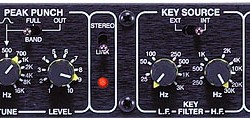Pro Series Compressors and Gates DS501 Power Gate

DS501 Power Gate
The DS501 is a sophisticated dual channel noise gate with fully tuneable ‘Peak Punch’ incorporating a number of features pioneered by Drawmer, which are invaluable to the sound engineer, and not found on conventional noise gates.
Some useful features:
- ‘Tuneable’ Peak Punch* (more info below)
- Variable high pass and low pass filters for “frequency conscious” gating
- Comprehensive envelope control, attack, hold, decay, and range
- Key input for external triggering
- “Key listen”
- Extremely fast attack time, to preserve the natural attack of the sound
- Balanced inputs and outputs
- Stereo linkable
- Can be used for “Gating” or “Ducking”
Positioned in the Drawmer range over the industry standard DS201 Dual Gate, the DS501 Power Gate features a new dual mode ‘tuneable’ Peak Punch* processing section on each channel. In tuneable mode a fully variable frequency selector with a range from 75Hz to 16kHz allows the user to shape the transients of the gated signal and ‘tune-in’ to the particular area of the audio spectrum where the Peak Punch is to be active. In addition a variable ‘more’ control allows the user to tailor the amount of processing. A secondary Full Band Peak Punch mode is also available.
Designed principally for drum and percussive gating applications, tuneable Peak Punch makes it possible to add transient punch to frequencies lacking in individual drum sounds, adding greater definition and presence to the gated signal. Using low frequency Peak Punch adds depth to thin drums, whilst higher frequency Peak Punch can dynamically emphasise rim shots or the ‘crack’ of a snare drum. Setting up noise gates can be tedious and unrewarding. For example, when attempting to separate a signal from unwanted noise or crosstalk that is relatively high in level, spurious triggering of the gate by unwanted components within the sound can be a serious problem. This can often be experienced in the studio when recording a drum kit. If a gate is used to clean up the snare drum sound it is quite likely that the nearby hi-hats will spill into the snare drum microphone and cause the gate to open. Increasing the threshold level may cure this problem, but then there is a very real danger that any quieter snare drum beats may not cause the gate to open at all and the performance can easily be ruined.
The DRAWMER solution to this problem is the inclusion of two variable filters, one high-pass and one low-pass, which act upon the side-chain keying circuitry. By setting the output switch to key listen the user can hear the action of the filters and adjust them to reject high frequency spillage from the hi-hats. This now enables the gate to only open on the lower frequencies present in the snare drum.
The very fast attack of the DS501 means that it can open in a matter of micro seconds, thus preserving the natural attack of whatever sound is being gated and the comprehensive envelope controls mean that the gain can be changed at whatever rate best suits the material being processed. With vocals for example, a fairly fast attack is needed so as not to clip the leading consonants but a slower release time will prevent the end of words being clipped off and will also fade out any noise gradually rather than cutting it off abruptly. This latter point is very important as the human ear is far more sensitive to rapidly changing noise levels than to a constant low level noise.
Another important role played by the gate is in the reshaping of existing sounds. An example of this might involve a simple sampling delay line used to store a sound to be re-triggered later and added to a mix. A gate can be used to impart a slower attack or faster decay to the sound and careful setting of the decay envelope can effectively hide any noise present at the end of the sample. When using a sampler or drum machine the gate can be considered a triggered envelope shaper, and the wide range allowed by the envelope controls make the DS501 ideal for this application.
The unit can be switched to accept a key input, which allows the gate to be triggered externally. An example of this would be to use a snare drum signal to open the gate on a separate ambient microphone to create a natural alternative to gated reverb.
Each channel can be individually switched from Gating to Ducking for ‘voice over’ applications or the removal of ‘clicks’ and ‘pops’.
*What is “TuneablePeak Punch”?
While the Drawmer gates are among the fastest responding gates in the industry, it still takes a finite amount of time for the sound level to reach the threshold at which the gate will open. When attempting to eliminate a high surrounding noise level, it’s possible to gate out the steep initial portion of a sharp transient, for example, the attack of a kick drum. The initial attack is necessary to give the sound its punch and determines how loud it sounds in the mix. If the attack is softened, it’s often necessary to run the level of the kick too high in the mix in order for it to be audible, robbing useful spectrum space. The Peak Punch circuit in the DS501 restores the attack by adding a gain boost for a very short period of time when the gate initially opens. We perceive the kick to be louder even though we’ve actually added very little energy by restoring the initial transient.
- Front View
